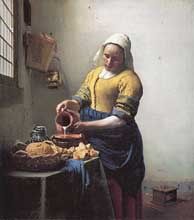A precursor to cinema?
 |
At one point, Vermeer was my favorite painter. I still think he's magnificent - although that is not really the word used to describe the quiet and almost serene paintings.
I was able to see The Milk Maid at the Metropolitan Museum of Art in New York. The painting was on loan from Holland's Rijksmuseum, to commemorate the 400th anniversary of Henry Hudson's voyage from Amsterdam to Manhattan. The museum's other five paintings by Vermeer were also on display, as well as paintings by Dutch artists who were contemporaries of Vermeer.
I won't say much about this painting, since I really had a just few minutes (maybe three) in front of it, since the gallery was so crowded. So, I will only write of my impressions.
As always, with Vermeer, I am struck by the light surrounding many of his subjects. This is a diffuse, all-over light, which illuminates them delicately, unlike the dramatic flashes that Rembrandt uses. Another thing that strikes me about these paintings (portraits, more like) is that they almost appear as though the subjects are moving, but not just performing their task, but moving (or about to move) their heads as though in contemplation. The milk maid stands with her jug ready to pour the milk, but at the same time, she could turn her head to look out of the window maybe to look for someone, or wishing she were outside.
I have done two pieces on Vermeer. One is an article, which I wrote sometime in 2006 (unpublished) which I called Vermeer's Discerning Light, an expository piece on this diffuse, gently illuminating light that Vermeer uses. You can read it hear.
The other is a short animation I did of The Lacemaker, again partly a contemplative piece, and partly a piece about this lacemaker’s task (although in the final version, I opted not to include movements of her hands working on the lace). The animation was done with Photoshop, then in a film editing software called Premier.
So, light and movement - a precursor to cinema, all those centuries ago.














